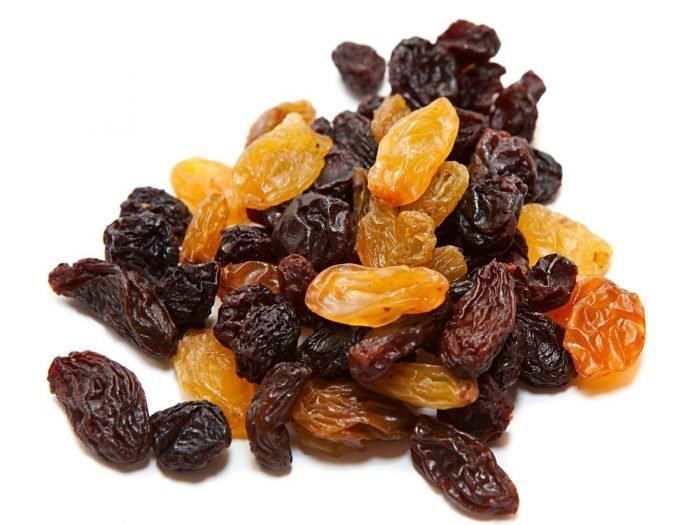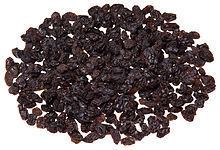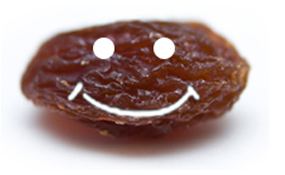Energy 1,252 kJ (299 kcal) Sugars 59.19 g Fat 0.46 g | Carbohydrates 79.18 g Dietary fiber 3.7 g Protein 3.07 g | |
 | ||
Similar Nut, Almond, Prune, Walnut, Sultana | ||
Grapes to raisins time lapse
A raisin is a dried grape. Raisins are produced in many regions of the world and may be eaten raw or used in cooking, baking, and brewing. In the United Kingdom, Ireland, New Zealand, and Australia, the word "raisin" is reserved for the dark-colored dried large grape, with "sultana" being a golden-colored dried grape, and "currant" being a dried small Black Corinth seedless grape.
Contents
- Grapes to raisins time lapse
- See how grapes are dried to become raisins ready to buy in the shops
- Etymology
- Varieties
- Nutrition
- Toxicity in pets
- Sugars
- Grades of raisins in the US
- Raisin production
- Pre treatment
- Drying
- Post drying processes
- Nutrition and health
- References

See how grapes are dried to become raisins ready to buy in the shops
Etymology

The word "raisin" dates back to Middle English and is a loanword from Old French; in modern French, raisin means "grape", while a dried grape is a raisin sec, or "dry grape". The Old French word, in turn, developed from the Latin word racemus, "a bunch of grapes".
Varieties

Raisin varieties depend on the type of grape used, and are made in a variety of sizes and colors including green, black, brown, blue, purple, and yellow. Seedless varieties include the sultana (the common American type is known as Thompson Seedless in the USA), the Greek currants (black corinthian raisins, Vitis vinifera L. var. Apyrena) and Flame grapes. Raisins are traditionally sun-dried, but may also be water-dipped and artificially dehydrated.
"Golden raisins" are treated with sulfur dioxide after drying to give them their golden color.

Black Corinth or Zante currant are miniature, sometimes seedless raisins that are much darker and have a tart, tangy flavor. They are often called currants. Muscat raisins are large compared to other varieties, and also sweeter.

Several varieties of raisins produced in Asia are available in the West only at ethnic grocers. Monukka grapes are used for some of these.
Nutrition

Raisins can contain up to 72% sugars by weight, most of which is fructose and glucose. They also contain about 3% protein and 3.7%–6.8% dietary fiber. Raisins, like prunes and apricots, are also high in certain antioxidants, but have a lower vitamin C content than fresh grapes. Raisins are low in sodium and contain no cholesterol.
Data presented at the American College of Cardiology's 61st Annual Scientific Session in 2012 suggest that, among individuals with mild increases in blood pressure, the routine consumption of raisins (three times a day) may significantly lower blood pressure, especially when compared to eating other common snacks.
Toxicity in pets
Raisins can cause renal failure in dogs. The cause of this is not known.
Sugars
Raisins are sweet due to their high concentration of sugars (about 30% fructose and 28% glucose by weight). The sugars can crystallise inside the fruit when stored after a long period, making the dry raisins gritty, but that does not affect their usability. These sugar grains can be dissolved by blanching the fruit in hot water or other liquids.
Grades of raisins in the U.S.
Raisin production
Raisins are produced commercially by drying harvested grape berries. For a grape berry to dry, water inside the grape must be removed completely from the interior of the cells onto the surface of the grape where the water droplets can evaporate. However, this diffusion process is very difficult because the grape skin contains wax in its cuticle, which prevents the water from passing through. In addition to this, the physical and chemical mechanisms located on the outer layers of the grape are adapted to prevent water loss.
The three steps to commercial raisin production include pre-treatment, drying, and post-drying processes.
Pre-treatment
Pre-treatment is a necessary step in raisin production to ensure the increased rate of water removal during the drying process. A faster water removal rate decreases the rate of browning and helps to produce more desirable raisins. The historical method of completing this process was developed in the Mediterranean and Asia Minor areas by using a dry emulsion cold dip made of potassium carbonate and ethyl esters of fatty acids. This dip was shown to increase the rate of water loss by two- to three-fold. Recently, new methods have been developed such as exposing the grapes to oil emulsions or dilute alkaline solutions. These methods can encourage water transfer to the outer surface of grapes which helps to increase the efficiency of the drying process.
Drying
The three types of drying methods are: sun drying, shade drying, and mechanical drying. Sun drying is an inexpensive process; however, environmental contamination, insect infections, and microbial deterioration can occur and the resulting raisins are often of low quality. Additionally, sun drying is a very slow process and may not produce the most desirable raisins. Mechanical drying can be done in a safer and more controlled environment where rapid drying is guaranteed. One type of mechanical drying is to use microwave heating. Water molecules in the grapes absorb microwave energy resulting in rapid evaporation. Microwave heating often produces puffy raisins.
Post-drying processes
After the drying process is complete, raisins are sent to processing plants where they are cleaned with water to remove any foreign objects that may have become embedded during the drying process. Stems and off-grade raisins are also removed. The washing process may cause rehydration, so another drying step is completed after washing to ensure that the added moisture has been removed.
All steps in the production of raisins are very important in determining the quality of raisins. Sometimes, sulfur dioxide is applied to raisins after the pre treatment step and before drying to decrease the rate of browning caused by the reaction between polyphenol oxidase and phenolic compounds. Sulfur dioxide also helps to preserve flavour and prevent the loss of certain vitamins during the drying process.
Nutrition and health
Raisins are rich in dietary fiber, carbohydrates with a low glycemic index, and minerals like copper and iron, with a low fat content. Raisins are often recommended as a snack for weight control because they help the control of glucose, the good functioning of the digestive system and the regulation of blood pressure. Replacing unhealthy snacks with raisins as a dietary habit has shown positive benefits in patients with type 2 diabetes, including reduced diastolic blood pressure and increased levels of plasma antioxidants. Corinthian raisins are a moderate glycemic index fruit that can be consumed in small amounts even by diabetic patients instead of sweets. Antioxidants in Greek raisins may reduce the risk for malignancies in the stomach and colon.
